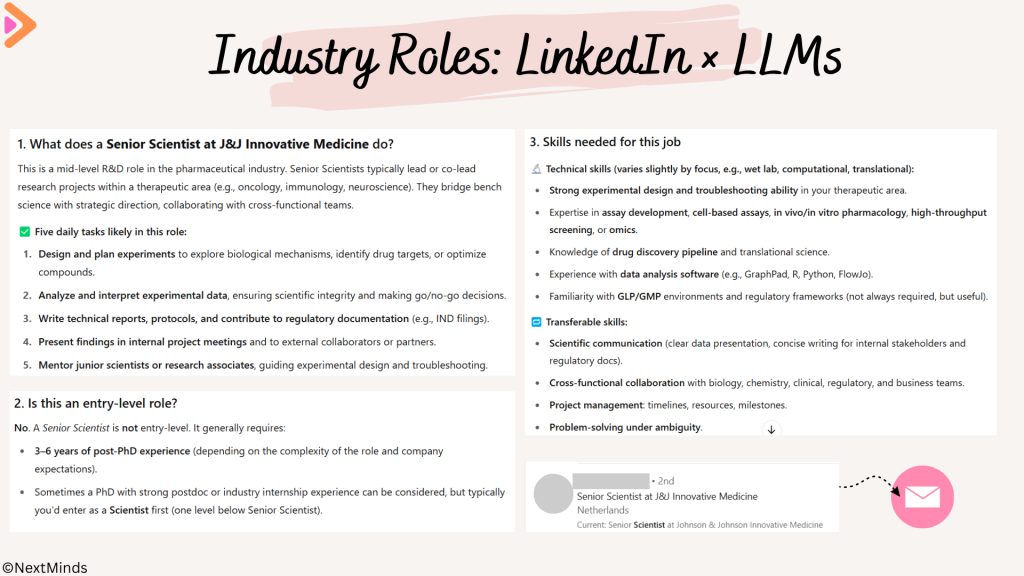
How to develop realistic industry perspectives as a PhD?
What’s the first job that comes to your mind when you think of life after the PhD?
If you’re like many of the PhD students I recently spoke to during a career development session, your answer might have included something like consultant, project manager, or even CEO. These were among the top job titles submitted when I asked the audience to name 1-3 industry roles a PhD could pursue.
But here’s the thing.
Many of the roles mentioned were senior – manager, senior scientist, even CEO. Not exactly entry-level, right?
I didn’t specify in the question whether the roles had to be realistic starting points right after a PhD. So technically, they didn’t answer wrong.
Still, it revealed something important:
🎯 Many researchers overestimate the level of seniority they can jump into after the PhD.
🎯 Many lack clarity about what entry-level industry positions even look like.
(That doesn’t surprise me; I also had no idea about this topic when I was doing my PhD)
The result? A mismatch between aspirations and actual job market entry points – which can lead to frustration, rejection, or simply not knowing where to start.
In today’s newsletter, I’ll help you build a more grounded, realistic view of industry possibilities – and give you a practical approach to explore them.
Disclaimer: this approach uses industry R&D roles as an example, but it can of course be applied to any job role – would it be in big companies, SMEs, start-ups, academia, science communication, government, NGOS, etc.
A practical method to research job roles
Here’s how to get a clearer, data-informed picture of what industry roles involve – and whether they suit you.
📌 All you need: LinkedIn and a large language model (LLM), such as ChatGPT, Claude, Gemini, or Le Chat.
Note: the free versions are perfectly fine for this type of assignment. I used ChatGPT for this example.
#1 | Search strategically on LinkedIn
Type the job title and company you’re curious about in the LinkedIn search bar.
For example: “Scientist” at “J&J”.
LinkedIn will show you profiles of people in that role. Open a few. Look at their background. Does it match yours? What kind of experience do they have?
#2 | Use a smart prompt with your LLM
Once you’ve identified a specific job title, plug this into your favorite AI tool with a prompt like:
“I’m a PhD graduate exploring careers in the pharmaceutical industry and want to better understand specific job roles.
Can you explain the following about the role ‘Senior Scientist at Johnson & Johnson Innovative Medicine’?
What are 5 typical daily tasks in this role?
Is it considered an entry-level position (0–3 years post-PhD)?
What technical and transferable skills should I highlight when applying?”

#3 | Interpret the result
Read the output. Does the job match your level and interests? If it sounds like a great fit – go deeper. If it doesn’t, that’s useful too. Cross it off your list and move on.
#4 | Take initiative
Found someone whose job intrigues you? Don’t hesitate to reach out and ask for a short digital coffee chat. Many are happy to share their experience if approached respectfully.

#5 | Repeat and get lost (productively) in the rabbit hole
Keep doing this for other roles you find online. It’s an excellent way to broaden your understanding and get a real sense of what’s out there – and where you might fit in.
📢 The Take-Home Message
💡Many PhD students aim too high too fast when exploring industry roles – without realizing it.
💡 You can shift this by researching real people in real roles using tools you already have.
💡 Curiosity, data, and initiative are your best allies for discovering what job titles truly match your profile.
Interested in receiving insights, tips and tools directly in your inbox? Sign up for the NextMinds Newsletter!
